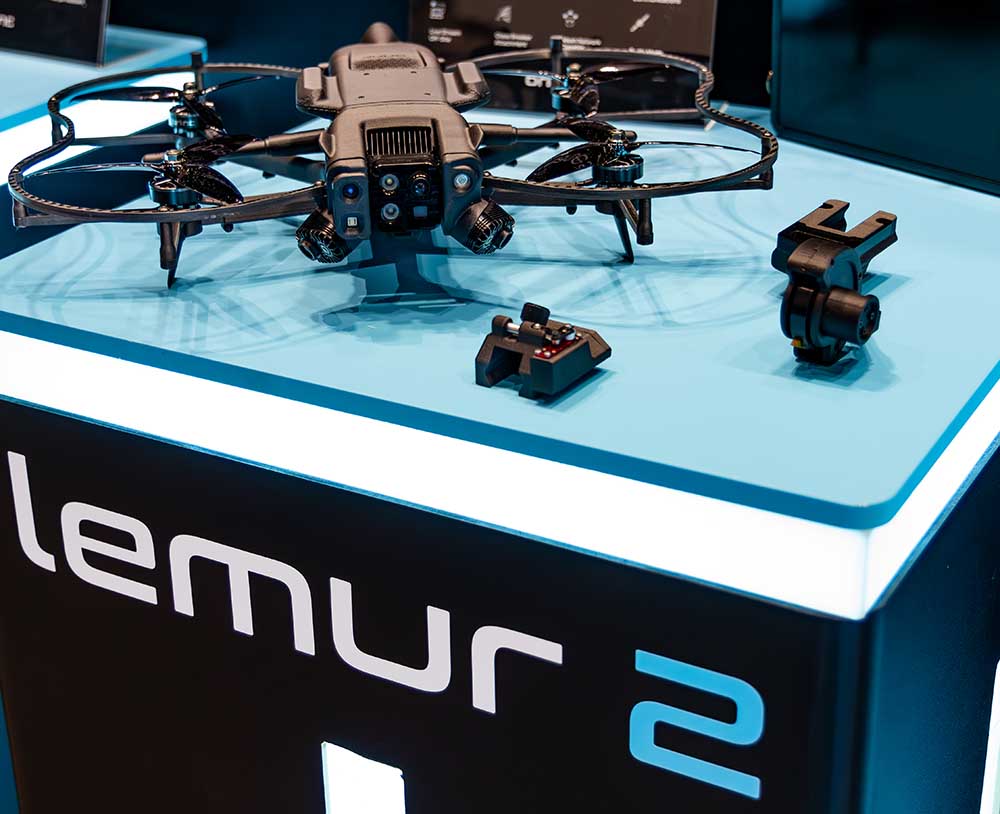When it was announced back in March, news about the LEMUR 2 from BRINC caused many in the industry to take notice. The first-of-its-kind sensor array would be able to include everything from LiDAR sensors to a tracking camera to two IR spotlights, which got safety professionals thinking about how they could use the drone to newly approach a variety of tasks. Today, those ideas are becoming reality with BRINC announcing the first deliveries of the LEMUR 2 to customers in US public safety agencies.
The story behind the creation of the original LEMUR drone is one that BRINC Founder and CEO Blake Resnick has recounted on various platforms, but many things have changed about the company and the drone industry as a whole since those early days. As revolutionary as it was, the LEMUR was ultimately a product that was developed in Resnick’s mother’s basement in a way that the term “bootstrapped” doesn’t begin to cover. Of course, improvements have been made and the product has been modified, but the core of the product was inherently connected to those especially humble origins.
The LEMUR 2 reflects the growth of the company (which is now nearly 100 people that mostly works out of BRINC’s Seattle-based headquarters) and product from those early days but is also indicative of how perceptions around drone technology itself have evolved.
“When I started working on what would become the original LEMUR drone, the idea of a S.W.A.T. team using a drone was seen as a weird concept,” Resnick told Commercial UAV News. “There were some real questions about the viability of the technology. Could you really fly a quadcopter indoors in the context of a S.W.A.T. mission? That’s why starting with something that was relatively simple was so important, because it allowed us to prove out the value and change those perceptions. Now that that's been accomplished, we’ve been able to invest a lot more in the underlying engineering and build out a finished product that makes sense to our customer base.”
That customer base is key, as the LEMUR 2 is specifically designed to be used to de-escalate dangerous situations, assist in search and rescue missions, and improve first responder safety. Many drone companies have one airframe that is designed to serve half a dozen markets or more, but the LEMUR 2 is specific to public safety needs that were identified in the context of serving and supporting S.W.A.T. teams. The approach enabled the BRINC team to develop features like the glass breaker, their two-way audio system, capabilities of operating in GPS-denied environments and more that helped change perceptions about how the technology could be utilized in these situations.
Many of those features have been taken to the next level with the LEMUR 2 though, which includes the following:
- GPS Denied/No Light Position Hold
- LiDAR and Tracking Camera Array
- Night Vision and FLIR Thermal Sensors
- Smart Battery Power Management
- FAA-compliant Remote ID Module
- Glass Breaker for Window Breaching
- Obstacle Awareness
- Two-way Audio Communications
- High-performance Antenna Array
- USB-C Charging Ecosystem
- NDAA Compliance
- Improved Self Righting Performance
Resnick explained the significance of each of these new features but was especially excited about the new mapping function. The LEMUR 2’s LiDAR array can provide real-time floor plans of its environment that are instantly available to any officer linked into the BRINC LiveOps system. Providing that kind of asset can make all the difference in a variety of situations.
“I really see it as an incredibly useful tool for first responders, because having a floor plan available to them before they make entry can be such a big deal,” Resnick explained. “We originally added those LiDAR capabilities to help with obstacle avoidance, but we quickly saw the rich point clouds would allow us to create a 2D slice of a 3D map, and that’s the floorplan our customers said they wanted and needed.”
That kind of asset speaks to the BRINC team’s commitment to providing much more than eyes in the sky, as the LEMUR 2 does that as a baseline but can also enable so many other metaphorical senses related to increased functionality and connectivity. One controller can be used to fly multiple aircraft at the same time as part of larger mesh networking function, meaning that every deployed drone is actually extending the range and improving the conductivity for every other drone and controller.
Such capabilities are the result of what public safety agencies can get from a drone that has been built for purpose, but how teams can approach leveraging these capabilities varies a great deal. Regardless of whether the LEMUR 2 is a team’s next drone or their first, the product was designed to make them feel comfortable, although users with different levels of experience with the technology will notice different things about it.
“This really is a product that you can hand to someone that has never flown a drone before,” Resnick mentioned. “On the other side of that, I think anyone familiar with our drones is going to be really impressed by the improved video quality, while the fit and finish of the hardware and software is hugely improved from our prior generation drums. Those established users are also going to notice the upgrades around two-way audio, because it can enable negotiations to happen a little bit more easily and more extended ranges. All of that said, they’re also going to be impressed by how much easier it is to use and that's really going to matter to our first responder customers.”
The LEMUR 2 is the first drone model from BRINC solely developed and manufactured in the company’s Seattle-based headquarters and production factory. For more information about the LEMUR 2 and the other public safety products offered by BRINC, please click here.
















Comments